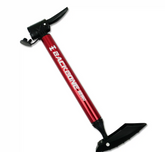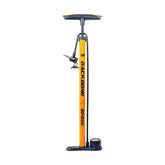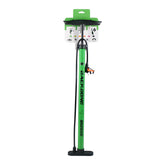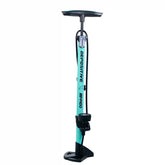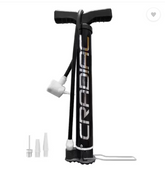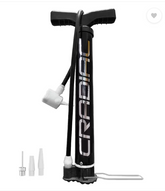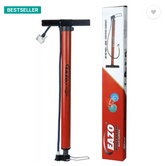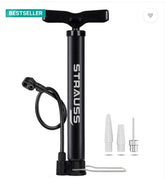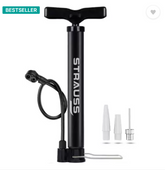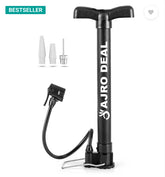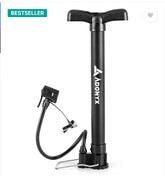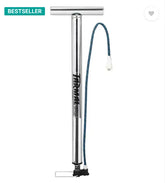Filter
16 results
15
- 10
- 15
- 20
- 25
- 30
- 50
Featured
- Featured
- Best selling
- Alphabetically, A-Z
- Alphabetically, Z-A
- Price, low to high
- Price, high to low
- Date, old to new
- Date, new to old
Sort
Sort by:
- Featured
- Best selling
- Alphabetically, A-Z
- Alphabetically, Z-A
- Price, low to high
- Price, high to low
- Date, old to new
- Date, new to old
-
The Backbone BB560 Mini Air Pump of cycle is an essential companion for every cyclist, designed to deliver efficient and reliable inflation on the go. Crafted from high-quality aluminum alloy, this mini hand pump is both lightweight and durable, ensuring it withstands the rigors...
- Rs. 390.00
- Rs. 390.00
- Unit price
- / per
-
Red
-
Black
-
Gray
-
Green
-
Backbone BB4500 High Pressure Floor Pump – Trusty Air Pump for CycleThe Backbone BB4500 High Pressure Floor Pump is designed for cyclists who require accurate and reliable inflation. Constructed with a robust steel alloy base, this cycle air pump offers superior stability, enabling easy and confident use. The large foot holder provides a secure grip while pumping, and the built-in pressure gauge provides accurate tire pressure readings, enabling you to keep your cycling performance at its peak.This bike air pump is very flexible, usable on both Schrader and Presta valves, so it will fit most types of bicycles. For added functionality, it also includes balloon...
- Rs. 770.00
- Rs. 770.00
- Unit price
- / per
-
Yellow
-
Orange
-
The Backbone BB 2500 Pump is your reliable partner for all your cycling adventures. Designed to handle a variety of situations, the air pump for cycles is suitable for both MTB and road bikes, making it an essential tool for every cyclist. Its twin valve design allows easy switching between Schrader...
- Rs. 590.00
- Rs. 590.00
- Unit price
- / per
-
Green
-
Yellow
-
Pink
-
Red
-
BePositive BB4400 Bicycle Floor Pump with Gauge – Reliable Air Pump for Cycle Achieve effortless inflation with the BePositive BB4400 Bicycle Floor Pump with Gauge. Designed for high performance, this air pump for cycle delivers up to 160 PSI (11 Bar), making it a...
- Rs. 990.00
- Rs. 990.00
- Unit price
- / per
-
Premium Twin-Head Bicycle Air Pump – Portable & Durable for All Your Inflation Needs Stay prepared for every ride with this bicycle air pump, designed to inflate bicycle tyres, sports equipment, rafts, and more with speed and ease. Whether you need to top up...
- Rs. 180.00
Rs. 799.00- Rs. 180.00
- Unit price
- / per
-
Cradiac Twin-Head Portable Bicycle Air Pump – Fast, Easy & Durable Inflation Stay ready for every ride and outdoor activity with this high-performance bicycle air pump, designed to quickly inflate bicycle tyres, sports balls, rafts, boats, pools, air beds, and balloons. No nozzle change...
- Rs. 350.00
- Rs. 350.00
- Unit price
- / per
-
Eazo Steel Bicycle Air Pump Stay prepared for any low-air emergency with the Eazo Steel Bicycle Air Pump, a powerful and reliable solution for all your inflation needs. Crafted with world-class technology, this bicycle air pump combines durability, efficiency, and versatility, making it an...
- Rs. 490.00
Rs. 550.00- Rs. 490.00
- Unit price
- / per
-
EAZO Multipurpose Bicycle Air Pump – Compact, Durable & Versatile Get the EAZO Multipurpose bicycle air pump for all your inflation needs – whether it’s bikes, cars, balls, or scooters. Designed for convenience and reliability, this high-quality pump works perfectly as a cycle air...
- Rs. 550.00
Rs. 600.00- Rs. 550.00
- Unit price
- / per
-
Double Action Bicycle Pump – Fast, High-Pressure Inflation for Every Ride Effortlessly inflate your tyres with the Double Action Bicycle Pump, the perfect solution for cyclists who demand speed and reliability. This high-pressure bicycle air pump delivers quick, efficient inflation for all your cycling...
- Rs. 173.00
Rs. 799.00- Rs. 173.00
- Unit price
- / per
-
Twin Head Multipurpose Bicycle Air Pump – Fast, Easy & Portable Inflation Get reliable, quick, and hassle-free inflation with the Twin Head Multipurpose Bicycle Air Pump, perfect for bicycles, rafts, boats, pools, air beds, balls, and more. Designed for versatility, it works as a...
- Rs. 200.00
Rs. 799.00- Rs. 200.00
- Unit price
- / per
-
High-Performance Double Action Multipurpose Air Pump – 165.5 PSI, 200 L/min Experience fast and efficient inflation with this versatile bicycle air pump, designed for multiple uses including ball, balloon, basketball pump, bicycle, football pump, motorcycle, volleyball pump, and float inflation. Built with Double Action...
- Rs. 263.00
Rs. 799.00- Rs. 263.00
- Unit price
- / per
-
ADONYX Portable Bike Floor |120PSI with Multifunction Needle|Mini Ball, Bicycle Pump (Black)No reviews
ADONYX Portable Bike Floor Pump – 120 PSI with Multifunction Needle (Black) Get reliable, fast, and convenient inflation with the ADONYX Portable Bike Floor Pump, designed for performance and portability. This high-pressure bicycle air pump delivers up to 120 PSI, making it perfect for...- Rs. 279.00
Rs. 799.00- Rs. 279.00
- Unit price
- / per
-
Heavy-Duty Steel Floor Bicycle Air Pump – Strong & Durable Design Upgrade your inflation experience with this premium bicycle air pump, built entirely from high-quality steel for unmatched durability. Perfect for bicycles, bikes, cars, balls, and footballs, this versatile pump works as a cycle...
- Rs. 359.00
Rs. 1,400.00- Rs. 359.00
- Unit price
- / per
-
Bicycle Air Pump with Dual Valve Compatibility – Presta & Schrader Experience quick and effortless inflation with this premium bicycle air pump, designed for both Presta and Schrader valves. Perfect for cyclists, commuters, and adventure riders, it works as a cycle air pump, air...
- Rs. 400.00
Rs. 600.00- Rs. 400.00
- Unit price
- / per
-
Portable Mini Pump – Aluminium Alloy with Built-in Hose Stay ready for every ride with this ultra-light bicycle air pump, perfect for cyclists who need reliability on the go. Made with a durable aluminium alloy inner barrel and ABS plastic outer body, this compact...
- Rs. 699.00
Rs. 799.00- Rs. 699.00
- Unit price
- / per

